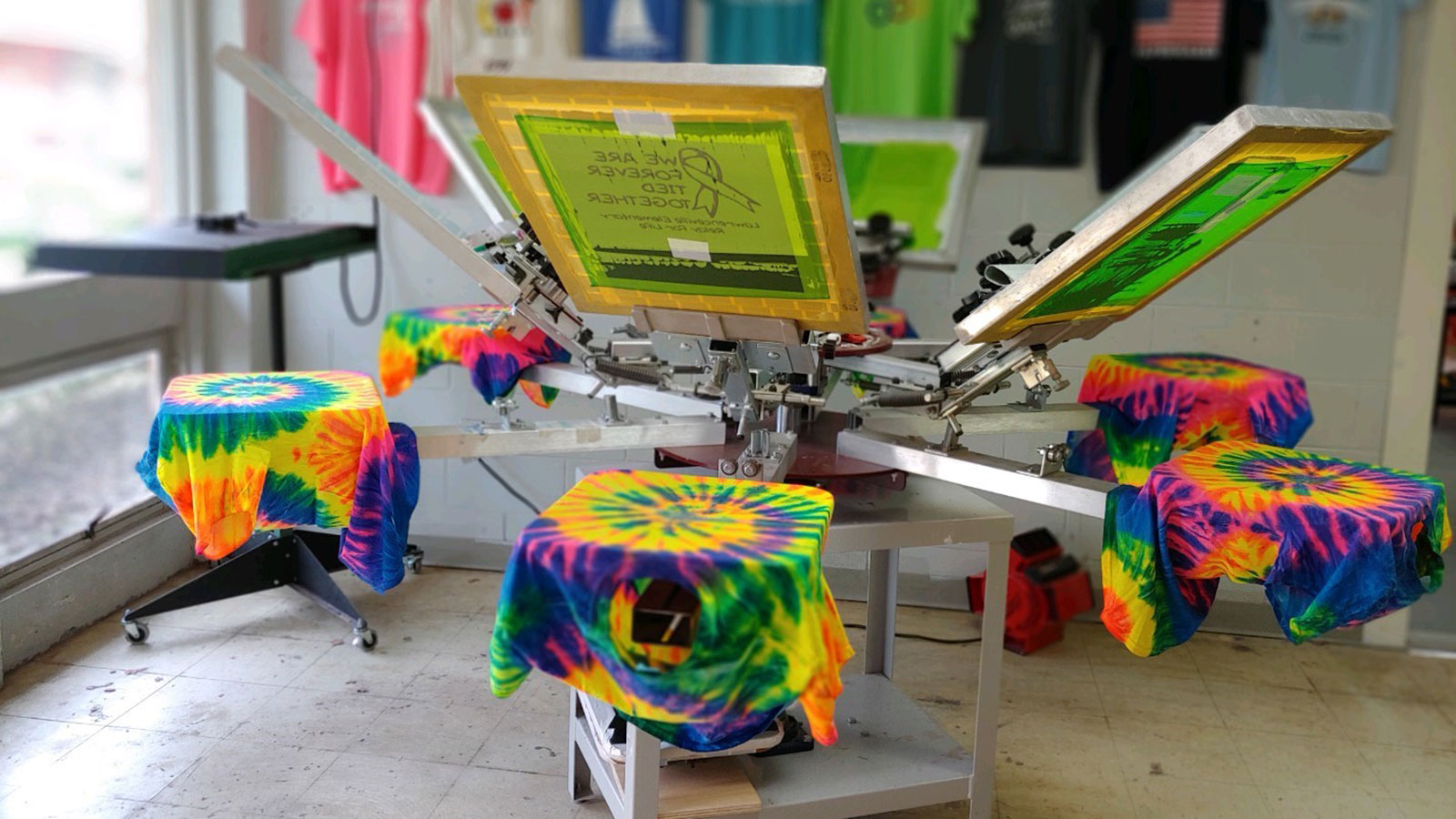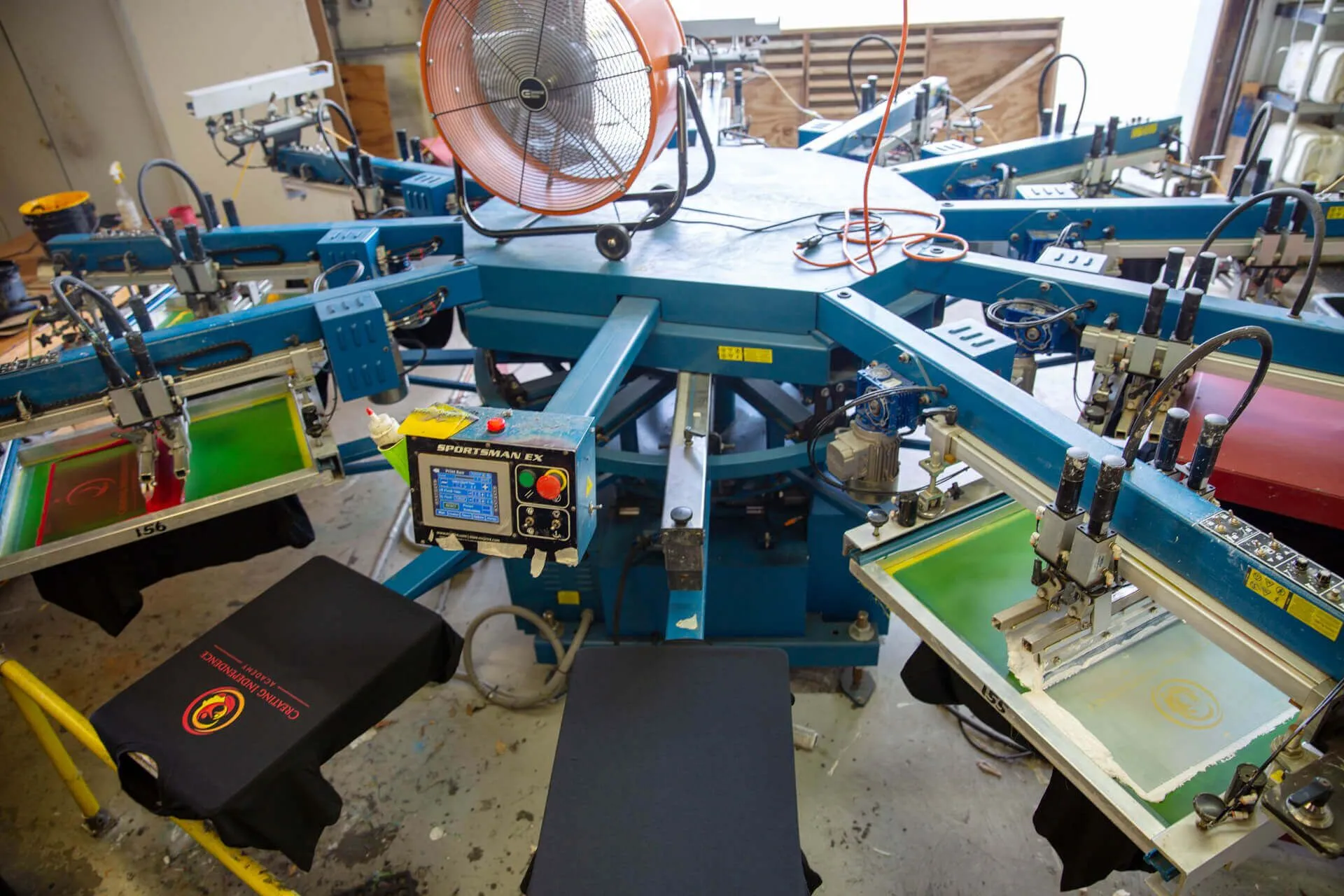Budget-Friendly T-Shirt Printing for Startups
Wiki Article
Screen Printing Uncovered: Whatever You Required to Understand About Tee and Garment Printing Techniques
Screen printing is an interesting technique that incorporates art with method, offering endless opportunities for creative thinking. All set to discover the essential aspects that make screen publishing an art kind?
The Basics of Screen Printing: How It Functions
When you plunge into screen printing, you'll find it's both an art and a science. At its core, display printing involves developing a stencil, or screen, that enables ink to pass through just in specific areas.Placement the display over the material, then make use of a squeegee to push ink with the screen onto the garment. Each action is vital, and understanding them will certainly elevate your screen printing abilities, transforming straightforward garments into distinct, meaningful pieces.
Types of Display Printing Techniques
As soon as you realize the fundamentals of display printing, it's time to check out the numerous methods that can raise your designs. One preferred method is typical screen printing, where ink is pushed with a stenciled screen.One more option is plastisol printing, known for its resilience and brilliant colors, making it a favored for many brand names. Experiment with halftone printing to develop slope effects and complex layouts.
Vital Equipment for Screen Printing
To accomplish stunning outcomes in screen printing, having the best devices is essential. You'll require a strong screen printing frame, which holds the mesh that moves your style onto the garment. Next off, invest in top notch mops; these are crucial for using ink evenly throughout the display.Selecting the Right Inks and Materials
When picking inks and products for screen printing, you require to take right into account the sort of ink that works ideal for your project. Consider textile compatibility to assure your styles look wonderful and last long. Likewise, check out green ink options to make your printing procedure much more sustainable.Types of Screen Inks
Choosing the best screen ink is crucial for accomplishing vivid, durable prints that meet your task's needs. There are several kinds of display inks to analyze. Plastisol ink is prominent for its versatility and convenience of use, providing excellent shade opacity on dark textiles. Water-based ink, on the various other hand, offers a softer feel and is environment-friendly, making it perfect for those aiming to minimize their ecological effect. Release inks eliminate color from the textile, leading to a soft, classic look however call for particular handling. Specialty inks, such as metal or glow-in-the-dark, can add special results to your layouts. Evaluate your task needs and select the ink that lines up best with your wanted result.
Material Compatibility Considerations
Understanding material compatibility is crucial for attaining high-grade display prints, particularly because various products respond distinctly to various inks. When picking inks, take into consideration the fabric kind-- cotton, polyester, or blends. For cotton, water-based inks work well, offering gentleness and breathability. Polyester, on the other hand, usually requires plastisol inks for much better adhesion and vivid shades. You might require to utilize a combination of both kinds if you're publishing on blends. Always test your inks on sample material to assure they adhere appropriately and maintain color integrity. In addition, keep in mind that fabric weight and appearance can affect the last result, so picking the ideal ink and product combination is essential for your job's success.Eco-Friendly Ink Options
Eco-friendly inks are ending up being a prominent option for screen printers who want to reduce their environmental influence while keeping quality. When choosing inks, consider water-based inks, which are much less damaging and much easier to cleanse up contrasted to conventional solvents.In addition, search for inks made from eco-friendly resources, such as soy or vegetable-based choices. By choosing the ideal inks and products, you'll not only produce sensational styles yet also add to an extra sustainable printing process. Make the button, and your prints will reflect your commitment to the atmosphere!
Preparing Your Style for Display Printing

Submit Format Requirements
To ensure your layout looks sharp and vivid on material, you'll require to pay very close attention to file layout needs for screen printing. Beginning with vector data like AI or EPS, as they can be scaled without shedding top quality. If you make use of raster pictures, opt for high-resolution data, such as TIFF or PNG, preferably at 300 DPI. Stay clear of using JPEGs, as they can shed quality when resized. Likewise, make certain your layout has a clear background to stop undesirable white sides on your prints. Keep color settings in mind; CMYK is basic for screen printing, so transform your RGB makes appropriately - screen printing kit. By adhering to these standards, you'll establish your artwork up for a successful print.Color Splitting Up Strategies
Shade separation is a necessary action in preparing your style for display printing, and grasping it can significantly boost your print top quality. You'll need to damage your style into specific shades, as each shade calls for a separate screen during printing. This precision not just assures exact color representation however likewise enhances the printing procedure.Resolution and Size
Attaining the most effective outcomes in display printing begins with ensuring your layout has the ideal resolution and size. Preferably, your art work ought to go to the very least 300 DPI (dots per inch) for sharp, clear prints. Your final item could look amateur and pixelated. if you make use of reduced resolution.When it concerns size, consider the measurements of your print location. Design your art work to match the last print dimension, ideally producing it in the actual measurements you'll be printing. This method, you'll avoid any kind of unforeseen scaling issues.
Always examine your style in both vector and raster styles. Vector graphics can be scaled without shedding quality, making them ideal for screen printing. Preparing appropriately will guarantee your style looks incredible on every garment!
Step-by-Step Display Printing Refine
Display printing is a vibrant process that permits you to develop lively designs on numerous surface areas. To obtain begun, you'll need a display, emulsion, and your chosen ink.After rinsing the unexposed solution, your screen prepares. Establish it up on your printing surface area and straighten your garment under it. Pour ink onto the display and make use of a squeegee to push the ink via the stencil onto the fabric. Lift the display thoroughly and allow the print dry. Ultimately, treat the ink making use of warm to assure longevity. That's it! You've successfully screen published your design.
Tips for Effective Screen Printing Projects
While you're diving right into your screen printing jobs, keep in mind that preparation is vital to success. Begin by collecting all your products-- inks, screens, squeegees, and garments. A tidy work area assists stop undesirable mistakes, so clean up before you begin.Next, verify your art work is high-resolution and appropriately sized for your garment. Check your display for correct direct exposure and clean it extensively to prevent spots. When mixing your inks, adhere to the maker's guidelines to attain the right consistency.
During printing, use also stress with your squeegee for constant outcomes. Do not hurry; take your time to validate each print meets your criteria. After printing, allow your garments dry completely before managing or packaging them.
Finally, constantly maintain an garment printing example of your work for future recommendation. In this manner, you can assess your development and improve your methods in time. Delighted printing!

Often Asked Concerns
How much time Does It Take to Establish a Screen Printing Work?
Setting up a screen printing work generally takes around half an hour to an hour. You'll prepare the screens, mix inks, and adjust journalism. The moment differs based upon complexity and experience, so remain arranged!Can I Publish on Various Material Types Making Use Of the Same Technique?
Yes, you can print on various textile types using the same strategy, however you'll need to readjust your setups and inks. Some materials soak up ink in different ways, so experimenting guarantees the ideal outcomes for every product.What Prevail Errors to Avoid in Screen Printing?
When screen printing, avoid typical mistakes like using the incorrect ink, ignoring appropriate direct exposure times, or skipping pre-press checks. Constantly test your arrangement and keep clean screens to ensure quality outcomes each time.Exactly How Can I Effectively Clean and Keep My Display Printing Tools?
To properly tidy and maintain your screen printing equipment, you need to routinely wash displays with proper solvents, examine mops for wear, and ensure all tools are stored dust-free and dry. Consistency avoids expensive repair work and boosts performance.Is Screen Printing Environmentally Pleasant Compared to Various Other Approaches?
Display printing can be much more eco-friendly than other methods, specifically if you make use of water-based inks and eco-conscious products. By picking lasting supplies and practices, you decrease waste and decrease your influence on the planet.Screen Printing Uncovered: Whatever You Required to Know Concerning T-Shirt and Garment Printing Methods
At its core, screen printing includes creating a pattern, or screen, that enables ink to pass through just in specific areas. Setting the screen over the textile, then make use of a squeegee to press ink through the screen onto the garment. One popular approach is conventional display printing, where ink is pushed through a stenciled display.When choosing inks and products for display printing, you require to take into account the type of ink that works finest for your task.
Report this wiki page